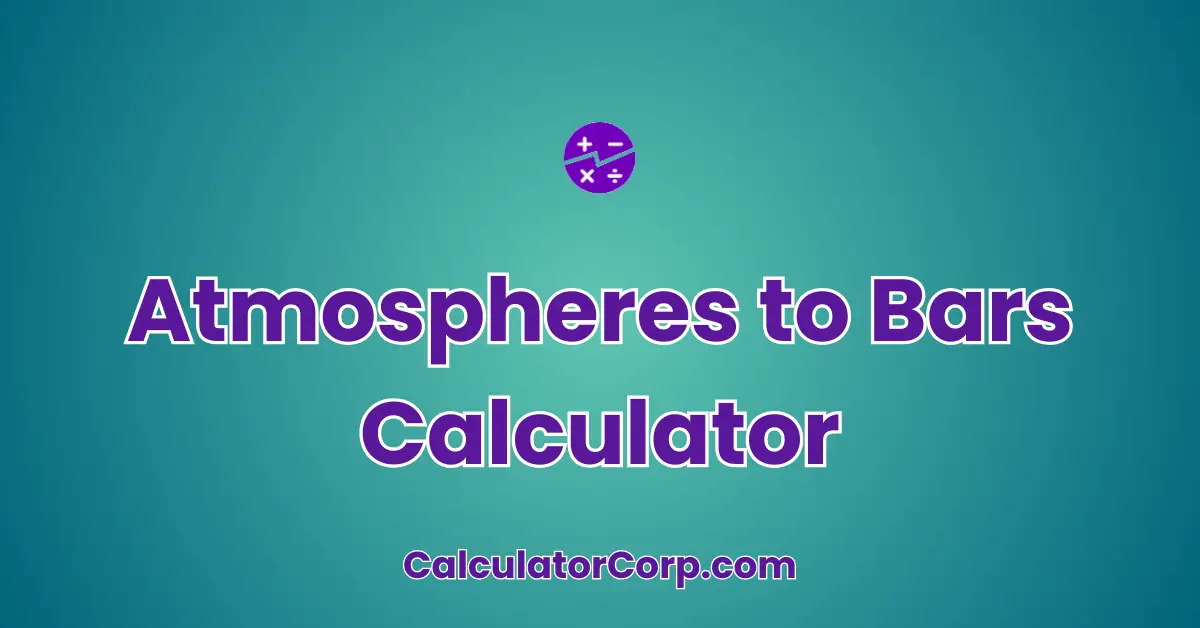The Atmospheres to Bars Calculator is a specialized tool used to convert pressure measurements from atmospheres (atm) to bars. This conversion is crucial in various scientific and engineering applications where precise pressure measurements are necessary. If you’re working in fields like meteorology, oceanography, or engineering, this calculator can help streamline your workflow by providing fast and accurate conversions.
How to Use the Atmospheres to Bars Calculator?
To use the calculator, simply enter the pressure in atmospheres into the input field. The converted value in bars will be displayed after you click the “Calculate” button. Remember to enter numerical values only, and ensure the input is in the correct format.
Once you have your result, you can interpret it as the equivalent pressure in bars. For instance, if you input 1 atm, you should receive approximately 1.01325 bars. This conversion is crucial for ensuring accuracy in scientific computations.
Tip: Avoid entering negative values or non-numerical characters. Also, consider how significant figures might influence your results, especially in high-precision tasks.
Backend Formula for the Atmospheres to Bars Calculator
The conversion formula used by the calculator is straightforward:
Formula: Bars = Atmospheres × 1.01325
This formula multiplies the given atmospheric value by 1.01325 to convert it into bars. This constant factor reflects the precise relationship between these two units under standard conditions.
For example, converting 2 atmospheres would involve multiplying 2 by 1.01325, resulting in 2.0265 bars. Variations of this formula are rarely needed, as this conversion is standardized across scientific disciplines.
Step-by-Step Calculation Guide for the Atmospheres to Bars Calculator
Step 1: Enter the pressure value in atmospheres into the calculator. For instance, if the pressure is 3 atm, input ‘3’.
Step 2: Click “Calculate” to perform the conversion. The calculator will multiply the input by 1.01325 to yield the result. For our example, 3 atm becomes 3.03975 bars.
Example 1: Convert 5 atm to bars. Result: 5 × 1.01325 = 5.06625 bars.
Example 2: Convert 0.5 atm to bars. Result: 0.5 × 1.01325 = 0.506625 bars.
Common Mistake: Double-check your entries, as incorrect input values can lead to inaccurate results. Ensure your calculations reflect the intended precision.
Real-Life Applications and Tips for Atmospheres to Bars
In real-world scenarios, converting atmospheres to bars is useful in fields like meteorology for predicting weather patterns, or in diving to ensure safe equipment pressure levels.
Short-term applications include immediate decision-making in laboratory settings, while long-term applications may pertain to infrastructure planning where pressure systems are involved.
Data Gathering Tips: Accurately measure atmospheric pressure using certified instruments to ensure reliable inputs.
Rounding and Estimations: Be aware of rounding errors, and use significant figures in high-precision tasks. A small difference can significantly impact outcomes in sensitive applications.
Atmospheres to Bars Case Study Example
Consider Alex, an oceanographer conducting deep-sea exploration. Alex needs to convert atmospheric pressure readings to bars to calibrate the pressure sensors on a submersible.
Before the dive, Alex uses the calculator to convert 10 atm to bars, resulting in 10.1325 bars. After the dive, Alex notes pressure changes and recalculates to ensure sensor accuracy.
Through these conversions, Alex ensures the submersible records pressure data accurately, enabling successful data collection for marine studies.
Alternative Scenarios: Architects may use the calculator to design pressure-resistant structures, while engineers might apply it in hydraulic system testing.
Pros and Cons of Atmospheres to Bars
Pros include time efficiency, as the calculator provides instant results compared to manual calculations. It enhances planning by enabling informed decision-making based on accurate data.
Cons include potential over-reliance on the tool, which might lead to errors if the input is incorrect. Additionally, minor estimation errors can occur without careful data input.
Mitigating Drawbacks: Cross-reference with additional tools or consult professionals when necessary to validate results and assumptions.
Example Calculations Table
| Atmospheres | Bars |
|---|---|
| 1 | 1.01325 |
| 2 | 2.0265 |
| 5 | 5.06625 |
| 10 | 10.1325 |
| 20 | 20.265 |
The table shows how increasing atmospheric input leads to a proportional increase in bars, demonstrating the linear relationship between these units.
General Insights: For most engineering purposes, a range between 1 to 10 atm is common, and knowing how each increment affects the pressure in bars is crucial for precision.
Glossary of Terms Related to Atmospheres to Bars
- Atmosphere (atm): A unit of pressure defined as 101,325 Pa. Used in meteorology and oceanography.
- Bar: A metric unit of pressure equal to 100,000 Pa, often used in meteorology and engineering.
- Pressure: The force applied perpendicular to the surface of an object per unit area. Measured in units like atm and bars.
Understanding these terms is essential for accurately interpreting pressure values and performing conversions.
Frequently Asked Questions (FAQs) about the Atmospheres to Bars
- Why use atmospheres to bars conversion?
Atmospheres to bars conversion is crucial for applications requiring pressure measurement in different units. The conversion keeps measurements consistent across various systems.
- How precise is the conversion?
The conversion is precise under standard conditions, but minor deviations can occur due to local atmospheric variations. Always consider the context of your readings.
- Can I use this for high-pressure environments?
Yes, the calculator is suitable for high-pressure scenarios, provided that the input values are within the instrument’s range and accuracy requirements.
- What should I do if my results seem off?
Double-check your input values, ensure the calculator settings are correct, and cross-reference with other tools if necessary.
- Is the formula universally accepted?
The formula used is widely accepted in scientific and engineering communities for standard atmospheric conditions. However, always verify against specific needs.
Further Reading and External Resources
- The Engineering Toolbox: Pressure Conversion – Explore detailed explanations and conversion charts for various pressure units.
- NIST: The Metric System – Learn about the metric system and its relevance to pressure measurements.
- NOAA Weather FAQs – Find out how atmospheric pressure is measured and applied in weather forecasting.

